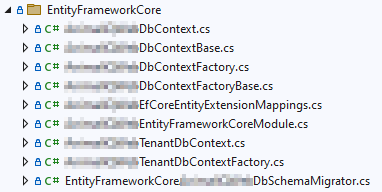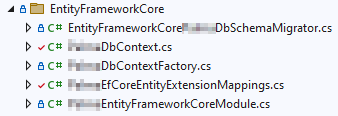In version 8.1, the following structure was generated by the Suite for the EntityFramework (for a Blazor Server project):

And now in 8.2.0-rc.3 it looks like this (for a Blazor Web App project):

Basically, I find it much clearer now. But I would like to add additions to the model, which I previously did in the “...DbContextBase” class. If I now do this in the “...DbContext” class, it will be deleted again the next time I generate it. How could I do this so that it remains there regardless of generation?
I would like to add the following for the decimal properties:
protected override void OnModelCreating(ModelBuilder builder)
{
base.OnModelCreating(builder);
builder.Entity<Disability>(b =>
{
b.Property(x => x.DegreeOfDisability).HasPrecision(18, 4);
});
}
Possibility for inheritance of entities.
https://learn.microsoft.com/en-us/ef/core/modeling/inheritance
https://community.abp.io/posts/inheritance-strategies-in-entity-framework-core-7-hg82tp4h?utm_source=twitter&utm_medium=announcement
I understand the problem... In my case, it's mainly about the modal control, which doesn't work. If at least that would work, I would be happy. I could live with the rest of the error messages. But without the modal control, of course the whole admin area doesn't work.
I think the Blazorise controls are the main problem. Can you address the need there as well?
There is already an issue there: https://github.com/Megabit/Blazorise/issues/5460
But which part of the code contains inline CSS? The one from ABP? The one from Blazorise? Because I have fixed everything in my code.
Have you been able to reproduce it with the ABP Suite template? What alternatives do I have if the customer insists on a secure CSP?
private void ConfigureSecurityHeaders()
{
Configure<AbpSecurityHeadersOptions>(options =>
{
options.UseContentSecurityPolicyHeader = true;
options.ContentSecurityPolicyValue = "base-uri 'self'; default-src 'none'; img-src 'self' data:; script-src 'self'; style-src 'self'; font-src 'self'; connect-src 'self'; frame-ancestors 'none'";
});
}
We have to apply certain CSPs (Content Security Headers) for our customer. I have problems with the following policy:
style-src 'self'
For example, the column widths are no longer set correctly in the DataGrid and, more importantly, the modal components are no longer displayed.
The policy looks like this:
options.UseContentSecurityPolicyHeader = true;
options.ContentSecurityPolicyValue = "base-uri 'self'; default-src 'none'; img-src 'self' data:; script-src 'self'; style-src 'self'; font-src 'self'; connect-src 'self'; frame-ancestors 'none'";
With style-src 'self' 'unsafe-inline' it would work... but is not allowed.
Need a solution as soon as possible... Thank you!
Thanks for the hint and the link.
I have now implemented this as follows:
AppService method:
[AuthorizeWithOrCondition(MyProjectPermissions.TargetSystems.UserWrite, MyProjectPermissions.TargetSystems.AgentWrite)]
public virtual async Task CreateAsync(TargetSystemCreateDto input)
{
...
}
AuthorizeAttribute:
public class AuthorizeWithOrConditionAttribute : AuthorizeAttribute, IAuthorizationRequirementData
{
public string[] PermissionNames { get; }
public AuthorizeWithOrConditionAttribute(params string[] permissionNames)
{
PermissionNames = permissionNames;
}
public IEnumerable<IAuthorizationRequirement> GetRequirements()
{
yield return new PermissionsRequirement(PermissionNames, requiresAll: false);
}
}
Our customer gives us a certain authorization structure that is not quite standard. Different permissions should grant access to a service method (not just one permission as usual).
Example:
If I use the AuthorizeAttribute twice, the permissions are AND combined. However, I need them with an OR combination.
I tried it with my own AuthorizeAttribute, but failed. It also didn't work in combination with my own AuthorizationHandler, as I couldn't access the AuthorizationService there (-> circular dependency).
The only variant that worked was to implement this directly in the service method:
public virtual async Task<TargetSystemDto> CreateAsync(TargetSystemCreateDto input)
{
var authUserWrite = await AuthorizationService.AuthorizeAsync(_currentPrincipalAccessor.Principal, null, MyProjectPermissions.TargetSystems.UserWrite);
var authAgentWrite = await AuthorizationService.AuthorizeAsync(_currentPrincipalAccessor.Principal, null, MyProjectPermissions.TargetSystems.AgentWrite);
if (!authUserWrite.Succeeded && !authAgentWrite.Succeeded)
{
throw new AbpAuthorizationException();
}
var targetSystem = await _targetSystemManager.CreateAsync(...);
return ObjectMapper.Map<TargetSystem, TargetSystemDto>(targetSystem);
}
But I would prefer to have this in an attribute. So that I could call it up as follows, for example:
[AuthorizeWithOrCondition(MyProjectPermissions.TargetSystems.AgentWrite, MyProjectPermissions.TargetSystems.UserWrite)]
How could this be realized? There must be a way...
Thanks, Adrian

